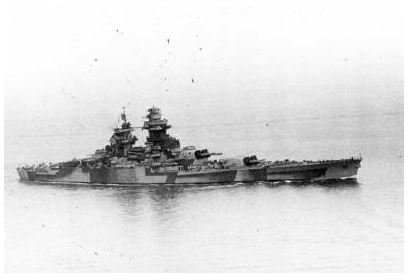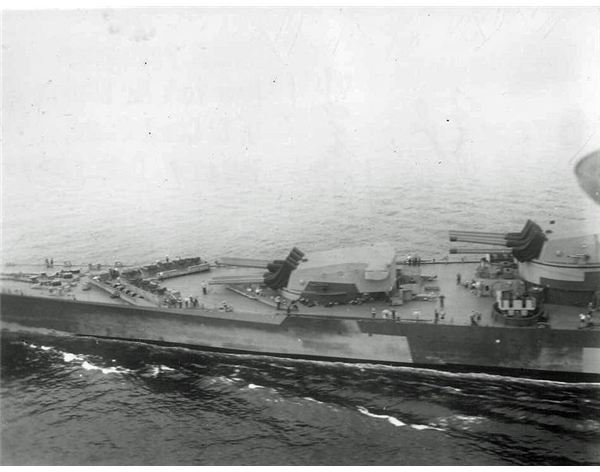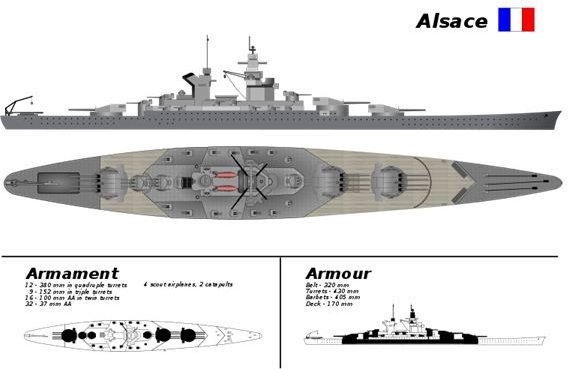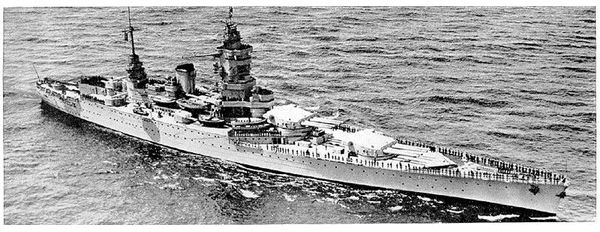The Alsace: Battleship to Head France's Navy in the 1940's
French Naval Requirements - Homeland Defense in Two Seas
Since it became a relatively cohesive nation in the late Middle Ages, France has faced threats from land and from sea on multiple fronts. By the late nineteenth century the traditional naval threat from the British Empire had waned but this old concern in the had been replaced by both the rapidly expanding Germany Imperial Navy, the Kaiserliche Marine, and the growing Italian Royal Navy in the Mediterranean.
Fortunately for France, Italy was an ally in the First World War which left France with only the dying Ottoman Empire’s navy and the small Austro-Hungarian flotilla to deal with in the Med. The war concluded without French shores having faced a danger greater than that posed by the German U-boat campaign - a form of warfare that posed a threat to France’s connections with its large overseas empire but less to its home provinces.
The 1930’s dramatically shifted the strategic situation. Fascist Italy was now generally hostile and slowly moved into the orbit of the newly revitalized German State under the National Socialist regime. Both powers were revanchist to the core and resented France’s position as the dominant land power in Europe and a major player in the Mediterranean. Italy and Germany began significant naval build ups that soon posed a major threat to French interests, and the French Navy began to plan for the possibility of a naval confrontation with either power.
The operating environments of the Atlantic and Mediterranean have always been distinct from one another, and France has always needed to build naval vessels that could handle both environments. Especially in the aviation age the Med rewards speed and mobility: no part of that sea is out of range of land based air power staged out of some nation’s territory, and any warship that cannot keep a step ahead of opposing air forces risks being caught and destroyed. The Atlantic by contrast rewards big guns, because battles may take place far from air cover and there’s almost always room to maneuver, leaving the vessel with the ability to outrange its opponent with an advantage. Endurance is also favored, as being able to absorb damage far from friendly territory and return to port afloat can mean the difference between ignominious national defeat at sea and the pride of having won a moral victory against a superior foe.
French Naval Responses to the Italo-German Threat Axis
The Alsace battleship class was but the latest in a series of post World War I designs meant to challenge any attempt by Italy or Germany to threaten French interests at sea. The Dunkerque Class began the series and was inspired largely by the danger (largely exaggerated) inherent in the pocket battleships - the German armored cruisers like the Deutschland class.
They were fast warships mounting thirteen inch guns in unusual quadruple turrets to minimize weight while still maintaining as many guns as possible in the design. They were built in accordance with the arms limitation agreements in effect at the time, but as their primary opponents were sub twenty thousand ton mixes between heavy cruisers and battle cruisers, their thirty-five thousand ton displacements made them far superior in most respects.
Although German naval rearmament continued throughout the ’30s the speed and quality of the equipment under construction did not concern French designers as much as that put forth by the Italian Regia Marina. The Vittorio Veneto class battleships built by Italy were armed with fifteen inch guns and built for speed. The French responded with the Richelieu class battleships, which were based off the Dunkerque design but armed with fifteen inch guns in quad turrets rather than the thirteen inch guns of their predecessors.

The Richelieu class was to be the pinnacle of French battleship development - the two of four planned that were eventually finished were actually not fully operational by the time France fell to the German onslaught in 1940. But even as these two vessels - Richelieu and Jean Bart - were launched the strategic naval competition changed tack yet again. The Bismarck and Tirpitz of the Krieg marine were largely complete by the time World War 2 began, and Germany planned to build an even larger version of the Bismarck class in the 1940’s. To keep pace, France needed battleships even more powerful than the Richelieu class, and so they began designing the Alsace class battleships.
The Alsace Class: Continuation of France’s Unique Design Philosophy
The Alsace class was never to be built - the collapse of the French Republic in 1940 meant that only two of four planned Richelieu battleships would ever see the light of day, so construction of the Alsace and her sisters were never even truly begun. But the French battleship Alsace was brought to the design phase, and certain aspects of the vessel’s likely configuration are known.
All nations improve upon previous designs when building a more modern class of ships but France is somewhat unique in that through the pre-war years it very pointedly took what was judged to be a good design - the Dunkerque class - and simply expanded the basic structure to meet changing circumstances. Just as the Richelieu class was to be a bigger iteration of the Dunkerque design, the Alsace battleship was intended as a further expansion.

The Alsace class was to continue the French use of quadruple turrets, but under one design option it would bring the total to three for a complement of twelve fifteen inch naval guns. This alone set the Alsace design apart, as the Bismarck and Tirpitz battleships were armed with eight fifteen inch guns in four twin turrets and even American battleships were only armed with nine guns, albeit sixteen inchers. Of course, as no vessel of the class was ever completed, the design may well have changed prior to completion - two quadruple turrets were the armament of a different design variant and may have proved to be a better configuration, or the three triple turret configuration as found on American, Japanese, and Italian battleships could have been adopted.
Aside from main armament the Alsace battleships were to be very similar to the preceding Richelieu. Nine six inch guns in three triple turrets comprised the secondary armament and anti-aircraft firepower was to consist of four inch guns and auto cannons ranging from 37mm to 57mm. One likely change that would have been made to the Alsace design if it had been under construction in the 1940’s would have been to its anti-aircraft armament. The threat of air power was not fully understood in 1940, but experience in the Pacific and Mediterranean rapidly demonstrated that even battleships could be smashed by aircraft. The sinking of the new battleship Prince of Wales by Japanese aircraft, the crippling of the Bismarck by torpedo wielding biplanes, and the destruction of battleships at Taranto and Pearl Harbor all demonstrated the need for revamped and dramatically increased anti-air capabilities. Alsace would almost certainly have seen its AAA complement boosted - reconstructed US battleships sunk at Pearl Harbor were given up to a hundred auto cannons and machine guns to fend off air attacks.
The Alsace Class at Sea and Their Possible Foes
Though they were never built the Alsace battleships’ use in the Atlantic and Mediterranean would likely have been geared towards protecting French installations and colonies both in France proper as well as North Africa. French battleships tended to be speedy but short ranged, so under most circumstances the Alsace and her sisters would have been expected to operate in the eastern Atlantic and Med, likely under friendly air cover. While battleship-battleship combat was relatively uncommon in World War II the final showdown with the Bismarck was an exception and in the confined spaces of the Med it would not have been out of the question for the Alsace to meet the Vittorio Veneto in combat.

In truth, the completion of the Alsace class battleships would have hinged on the war not beginning until the mid-1940’s. Even if France had not collapsed in 1940 it is unlikely, as with Germany, that battleship construction would have been prioritized over building tanks and aircraft. Like the German “H” design the Alsace class would have most likely been canceled on the slipways. Of course, if the war had not begun until 1945 the Alsace battleships would have faced a dramatically different threat environment. The German Z Plan aimed to build a balanced fleet with aircraft carriers, half a dozen or more updated and enlarged Bismarcks, and a dozen or so armored cruisers and battle cruisers. If completed, the combined threat of Germany, Italy, and Japan may have meant that French Alsace battleships would have faced direct naval attacks on French colonies and port facilities. It is even plausible that they would have gone up against the H class or the Yamatos gun to gun while an air battle raged overhead.
That the French battleship force would make a good account for itself in such a situation is without question. Though not engaged in combat during much of the Second World War, French battleships were attacked by the British and Americans both between 1940 and 1942. Though perhaps not as well armed or armored as their contemporaries no modern French battleships were permanently sunk by hostile fire - the Dunkerques were scuttled to prevent the Germans from taking them over later in the war and formed the only loss of modern battleships suffered by France during the war. The half-incomplete Richelieu and Jean Bart survived the war to form the nexus of the French Navy into the 1960s, by which time the aircraft carrier was clearly the capital ship of the future.
Sources:
Janes Fighting Ships of World War II, 1946 Janes Publishing Company, 1994 reprint edition
Winston Churchill, The Second World War, 1959 Time Life
Barrie Pitt, The Battle of the Atlantic, 1977 Time Life Books
Image Credits: Photos courtesy of the US Navy, Diagram courtesy of Wikipedia user Rama.
